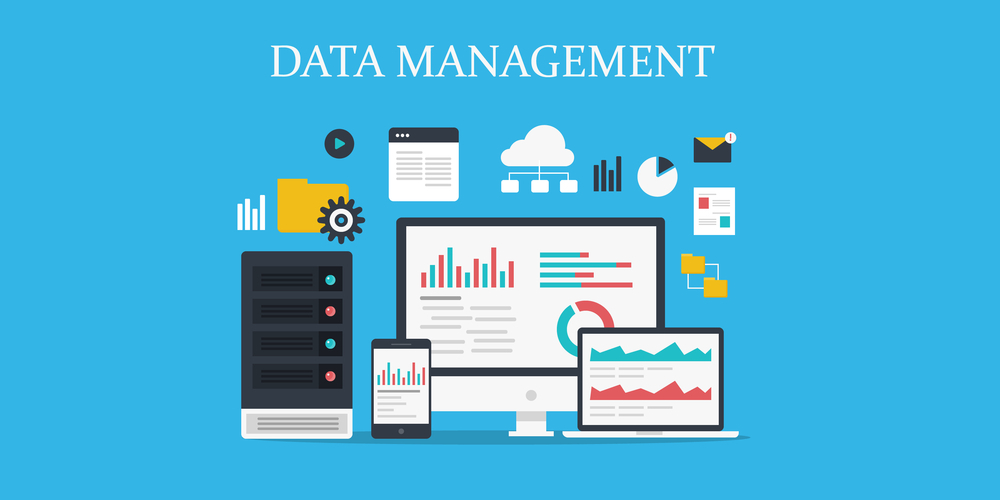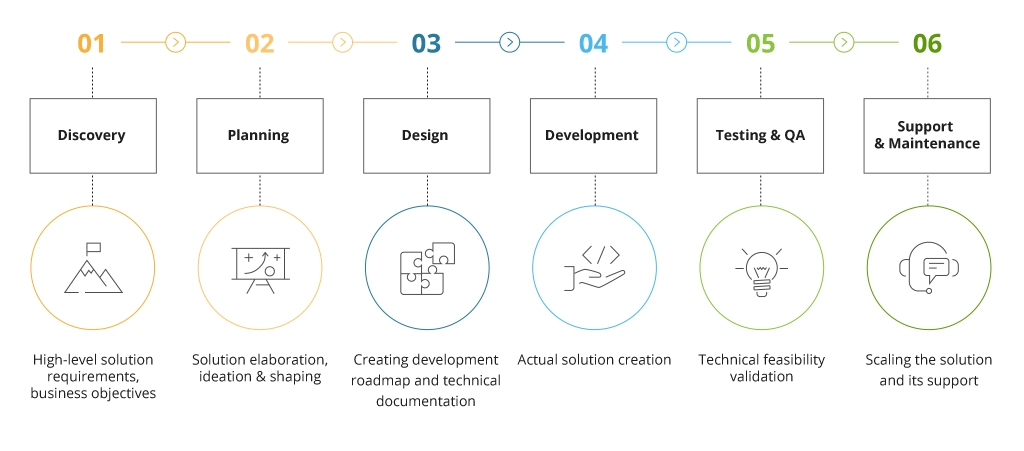What are Data Management Services: Types, Tools & Life Cycle
In today’s digital age, businesses and organizations are generating and accumulating vast amounts of data at an unprecedented rate. The sheer volume of data can be overwhelming, from customer information to financial records and product inventories to marketing analytics. Without proper organization and management, this wealth of information can quickly become a burden rather than an asset.
Efficient data management is crucial for businesses of all sizes and industries. It involves the processes and technologies used to collect, store, organize, and analyze data to maximize its value and accessibility.
By implementing effective data management services, businesses can streamline their operations, make informed decisions, improve customer experiences, and gain a competitive edge in the market.
What is Data Management, and Why is it Important?

Data management refers to collecting, storing, organizing, and maintaining data in a structured and controlled manner. It involves various activities such as data acquisition, validation, transformation, integration, storage, retrieval, and analysis. Data management aims to ensure that data is accurate, consistent, secure, and easily accessible for authorized users.
Data management is crucial for organizations of all sizes and across various industries. Here are several reasons why it is important:
Decision-making
Data serves as the foundation for making informed business decisions. By effectively managing data, organizations can access accurate and up-to-date information to make strategic decisions based on facts rather than assumptions or intuition. This can improve operational efficiency, better resource allocation, and increased competitiveness.
Data quality
Data management practices help maintain data quality by ensuring accuracy, completeness, consistency, and reliability. Poor data quality can significantly impact business operations, decision-making processes, customer satisfaction, and regulatory compliance. Organizations can identify and rectify data issues by implementing data management strategies and tools before they cause problems.
Compliance and security
Data management is crucial in ensuring compliance with legal and regulatory data privacy and security requirements. Organizations need to protect sensitive information from unauthorized access or breaches. Data management practices include implementing security measures such as encryption, access controls, backup systems, and disaster recovery plans to safeguard data from potential threats.
Efficient operations
Effective data management streamlines business operations by providing easy access to relevant information when needed. It eliminates redundant or duplicate data, reduces manual searching for information, and improves overall productivity. With well-organized data repositories and efficient retrieval mechanisms, employees can quickly find the information they need to perform their tasks effectively.
Data integration
Many organizations have multiple systems or databases that store different types of data. Data management facilitates the integration of these disparate data sources, enabling a holistic view of the organization’s information. Integrated data allows for better analysis, reporting, and decision-making across departments or business units.
Types of Data Management
Data management involves collecting, organizing, storing, and utilizing data systematically and efficiently. It involves various activities and techniques to ensure data quality, accessibility, security, and compliance. Organizations employ several types of data management to handle their data assets effectively. These include:
Data Integration
Data integration combines data from different sources or systems into a unified view. It aims to provide a comprehensive and consistent data representation across the organization. This process often includes extracting data from various sources, transforming it into a common format, and loading it into a target system or data warehouse.
Data Modeling
Data modeling creates a conceptual or logical representation of data structures and relationships. It helps understand the organization’s data requirements and design databases or data warehouses accordingly. Data models can define entities, attributes, relationships, and constraints, enabling efficient data storage and retrieval.
Data Storage
Data storage refers to the physical or virtual infrastructure used to store and manage data. It includes various technologies such as databases, data warehouses, file systems, cloud storage, and distributed storage systems. The choice of storage technology depends on factors like scalability, performance, reliability, cost, and specific use cases.
Data Catalogs
Data catalogs are centralized repositories that provide metadata about available datasets within an organization. They serve as a catalog or inventory of all the data assets in different systems or databases. Data catalogs help discover relevant datasets, understand their structure and content, and facilitate collaboration among users.
Data Processing
Data processing involves transforming raw data into meaningful information through various operations such as filtering, aggregating, sorting, joining, or analyzing the data. It can be performed using tools and technologies like databases, big data frameworks (e.g., Hadoop), or specialized analytics platforms.
Data Governance
Data governance encompasses the policies, processes, and controls that ensure the proper management and usage of data across an organization. It involves defining data standards, roles, responsibilities, and guidelines to ensure data quality, privacy, security, and regulation compliance. Data governance aims to establish a framework for data management and decision-making.
Data Lifecycle Management (DLM)
Data lifecycle management refers to managing data throughout its entire lifecycle, from creation to archival or deletion. It defines policies and procedures for data retention, backup, recovery, archiving, and disposal. DLM ensures that data is properly managed at each stage to optimize storage resources and meet regulatory requirements.
Data Pipelines and ETLs
Data pipelines are processes or workflows that extract data from various sources, transform it into a desired format, and load it into a target system or database. Extract, Transform, Load (ETL) is a common data integration and processing approach. ETL tools facilitate the automation of these processes, enabling efficient data movement and transformation.
Data Security
Data security protects data from unauthorized access, disclosure, alteration, or destruction. It involves implementing security measures such as encryption, access controls, authentication mechanisms, and monitoring systems to safeguard sensitive data. Data security ensures the confidentiality, integrity, and availability of data assets.
Data Architecture
Data architecture refers to designing and structuring an organization’s data assets and relationships. It includes defining data models, schemas, storage systems, integration patterns, and access mechanisms. A well-designed data architecture provides a foundation for effective data management and supports various business applications and analytics.
Data Management Tools and Techniques: Navigating the Data Landscape
Data management tools and techniques are crucial in navigating the data landscape. In today’s digital age, organizations generate and collect vast amounts of data from various sources. Effectively managing this data is essential for businesses to gain insights, make informed decisions, and drive growth.
Data Management Tools:
Relational Database Management Systems (RDBMS)
RDBMS is one of the most widely used data management tools. It organizes data into tables with rows and columns, allowing for efficient storage, retrieval, and manipulation of structured data. Popular RDBMSs include Oracle Database, MySQL, Microsoft SQL Server, and PostgreSQL.
NoSQL Databases
NoSQL databases are designed to handle unstructured or semi-structured data that does not fit well into the rigid structure of traditional relational databases. These databases provide flexibility in storing and retrieving large volumes of diverse data types. Examples of NoSQL databases include MongoDB, Cassandra, Couchbase, and Redis.
Data Warehousing Tools
Data warehousing tools enable organizations to consolidate and integrate data from various sources into a central repository known as a data warehouse. These tools facilitate the extraction, transformation, and loading (ETL) process to ensure data quality and consistency. Popular data warehousing tools include IBM InfoSphere DataStage, Microsoft SQL Server Integration Services (SSIS), Oracle Data Integrator (ODI), and Talend.
Data Integration Tools
Data integration tools help organizations combine data from different sources and formats into a unified view. These tools enable seamless data flow between systems by providing connectors, transformations, and mappings to ensure compatibility and consistency across datasets. Examples of data integration tools include Informatica PowerCenter, IBM InfoSphere Information Server, Talend Data Integration, and Microsoft SQL Server Integration Services (SSIS).
Data Governance Tools
Data governance tools assist organizations in establishing policies, processes, and controls to ensure data quality, integrity, and compliance. These tools enable data stewards to define and enforce standards, monitor usage, and manage data lifecycle. Popular data governance tools include Collibra, Informatica Axon, IBM InfoSphere Information Governance Catalog, and Talend Data Fabric.
Master Data Management (MDM) Tools
MDM tools help organizations create and maintain a single, accurate, consistent view of master data across multiple systems and applications. These tools provide data cleansing, deduplication, synchronization, and governance capabilities to ensure data quality and reliability. Examples of MDM tools include Informatica MDM, IBM InfoSphere MDM, Oracle Customer Hub, and Talend MDM.
Data Visualization Tools
Data visualization tools enable organizations to present complex data in a visually appealing and easily understandable format. These tools help users explore and analyze data through interactive charts, graphs, dashboards, and reports. Popular data visualization tools include Tableau, Microsoft Power BI, QlikView, and D3.js.
Data Management Techniques:
Data Modeling
Data modeling is designing the structure and relationships of a database or data warehouse. It involves identifying entities, attributes, and relationships to create a conceptual, logical, and physical data representation. Data modeling techniques such as entity-relationship diagrams (ERDs) or Unified Modeling Language (UML) diagrams help understand the data requirements and ensure data integrity.
Data Quality Management
Data quality management techniques aim to improve data accuracy, completeness, consistency, timeliness, and validity. This includes activities such as data profiling to identify anomalies or inconsistencies, data cleansing to remove errors or duplicates, and data enrichment to enhance the quality of existing data.
Data Security and Privacy
Data security techniques involve implementing measures to protect sensitive or confidential data from unauthorized access, alteration, or disclosure. This includes encryption, access controls, firewalls, intrusion detection systems, and regular security audits. Data privacy techniques ensure compliance with data protection regulations and safeguard individuals’ personally identifiable information (PII).
Data Integration and ETL
Data integration techniques combine data from disparate sources to create a unified view. Extract, Transform, Load (ETL) is a common technique used to extract data from source systems, transform it into a consistent format, and load it into a target system such as a data warehouse. ETL tools automate this process and provide data cleansing, validation, and transformation functionalities.
Data Governance and Metadata Management
Data governance techniques establish policies, processes, and controls to ensure the proper management and use of data assets. This includes defining data ownership, roles, and responsibilities and establishing data stewardship practices. Metadata management techniques involve capturing and managing metadata (data about data) to provide context, lineage, and understanding of the underlying data.
Data Analytics and Business Intelligence
Data analytics techniques involve using statistical analysis, machine learning algorithms, and visualization tools to uncover patterns, trends, and insights from data. Business intelligence techniques focus on transforming raw data into meaningful information for decision-making. These techniques include ad-hoc querying, reporting, OLAP (Online Analytical Processing), and data mining.
Data Management Program Life Cycle

The Data Management Program Life Cycle is a systematic approach encompassing all the stages of managing data within an organization. It begins with the planning phase, where the objectives and requirements of the data management program are defined. This is followed by the analysis phase, where the existing data assets and processes are assessed to identify gaps and opportunities for improvement.
The design phase involves creating a blueprint for the data management program, including data governance policies, models, and integration strategies. The implementation phase focuses on executing the designed program, including data cleansing, migration, and system integration. Once implemented, the program enters the operation and maintenance phase, where ongoing monitoring, performance optimization, and data quality management occur. Finally, the program concludes with the retirement phase, where data assets are archived or disposed of according to legal and regulatory requirements.
Data Management Services FAQ
What are data management services?
Data management services refer to the processes and strategies implemented to collect, organize, store, secure, and analyze data to ensure its accuracy, accessibility, and usefulness. These services involve various activities such as data integration, data cleansing, data governance, and data security.
What are the four types of data management?
Data management can be classified into four main categories: operational data management, strategic data management, tactical data management, and reference data management.
Which one is an example of data management services?
One example of data management services is Amazon Web Services (AWS), which offers various data management solutions, including database services, data warehousing, and data analytics.
What is the main purpose of data management?
The main purpose of data management is to ensure the effective and efficient handling, storage, organization, and utilization of data to support decision-making processes and achieve organizational goals.






